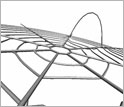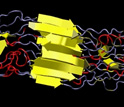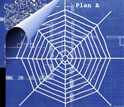News Release 12-016
A Spider Web's Strength Lies in More Than its Silk
Sacrificial beams and stress-dependent materials--concepts of interest to modern engineering--are critical in keeping webs strong

This image shows how a spider web responds to stress, from web scale to the scale of proteins.
February 1, 2012
View a video interview with Markus Buehler of MIT, an animation of a spider web under extremes stresses, and an animation of a spider web subjected to mechanical forces.
This material is available primarily for archival purposes. Telephone numbers or other contact information may be out of date; please see current contact information at media contacts.
While researchers have long known of the incredible strength of spider silk, the robust nature of the tiny filaments cannot alone explain how webs survive multiple tears and winds that exceed hurricane strength.
Now, a study that combines experimental observations of spider webs with complex computer simulations shows that web durability depends not only on silk strength, but on how the overall web design compensates for damage and the response of individual strands to continuously varying stresses.
Reporting in the cover story of the Feb. 2, 2012, issue of Nature, researchers from the Massachusetts Institute of Technology (MIT) and the Politecnico di Torino in Italy show how spider web-design localizes strain and damage, preserving the web as a whole.
"Multiple research groups have investigated the complex, hierarchical structure of spider silk and its amazing strength, extensibility and toughness," says Markus Buehler, associate professor of civil and environmental engineering at MIT. "But, while we understand the peculiar behavior of dragline silk from the 'nanoscale up'--initially stiff, then softening, then stiffening again--we have little insight into how the molecular structure of silk uniquely improves the performance of a web."
The spider webs found in gardens and garages are made from multiple silk types, but viscid silk and dragline silk are most critical to the integrity of the web. Viscid silk is stretchy, wet and sticky, and it is the silk that winds out in increasing spirals from the web center. Its primary function is to capture prey. Dragline silk is stiff and dry, and it serves as the threads that radiate out from a web's center, providing structural support. Dragline silk is crucial to the mechanical behavior of the web.
Some of Buehler's earlier work showed that dragline silk is composed of a suite of proteins with a unique molecular structure that lends both strength and flexibility. "While the strength and toughness of silk has been touted before--it is stronger than steel and tougher than Kevlar by weight--the advantages of silk within a web, beyond such measures, has been unknown," Buehler adds.
The common spiders represented in the recent study, including orb weavers (Nephila clavipes), garden spiders (Araneus diadematus) and others, craft familiar, spiraling web patterns atop a scaffolding of radiating filaments. Building each web takes energy the spider cannot afford to expend often, so durability is key to the arachnid's survival.
Through a series of computer models matched to laboratory experiments with spider webs, the researchers were able to tease apart what factors play what role in helping a web endure natural threats that are either localized, such as a twig falling on a filament, or distributed, such as high winds.
"For our models, we used a molecular dynamics framework in which we scaled up the molecular behavior of silk threads to the macroscopic world. This allowed us to investigate different load cases on the web, but more importantly, it also allowed us to trace and visualize how the web fractured under extreme loading conditions," says Anna Tarakanova, who developed the computer models along with Steven Cranford, both graduate students in Buehler's laboratory.
"Through computer modeling of the web," Cranford adds, "we were able to efficiently create 'synthetic' webs, constructed out of virtual silks that resembled more typical engineering materials such as those that are linear elastic, like many ceramics, and elastic-plastic materials, which behave like many metals. With the models, we could make comparisons between the modeled web's performance and the performance seen in the webs made from natural silk. In addition, we could analyze the web in terms of energy, and details of the local stress and strain," which are traits experiments were able to reveal.
The study showed that, as one might expect, when any part of a web is perturbed, the whole web reacts. Such sensitivity is what alerts a spider to the struggling of a trapped insect. However, the radial and spiral filaments each play different roles in attenuating motion, and when stresses are particularly harsh, they are sacrificed so that the entire web may survive.
"The concept of selective, localized failure for spider webs is interesting since it is a distinct departure from the structural principles that seem to be in play for many biological materials and components," adds Dennis Carter, the NSF program director for biomechanics and mechanobiology who helped support the study.
"For example, the distributed material components in bone spread stress broadly, adding strength. There is no 'wasted' material, minimizing the weight of the structure. While all of the bone is being used to resist force, bone everywhere along the structure tends to be damaged prior to failure."
In contrast, a spider's web is organized to sacrifice local areas so that failure will not prevent the remaining web from functioning, even if in a diminished capacity, says Carter. "This is a clever strategy when the alternative is having to make an entire, new web," he adds. "As Buehler suggests, engineers can learn from nature and adapt the design strategies that are most appropriate for specific applications."
Specifically, when a radial filament in a web is snagged, the web deforms more than when a relatively compliant spiral filament is caught. However, when either type fails--under great stress--it is the only filament to fail.
The unique nature of the spider-silk proteins enhances that effect. When a filament is pulled, the silk's unique molecular structure--a combination of amorphous proteins and ordered, nanoscale crystals--unfurls as stress increases, leading to a stretching effect that has four distinct phases: an initial, linear tugging; a drawn out stretching as the proteins unfold; a stiffening phase that absorbs the greatest amount of force; and then a final, stick-slip phase before the silk breaks.
According to the researchers' findings, the failure of silk threads occurs at points where the filament is disturbed by that external force, but after failure, the web returns to stability--even in simulations using broad forces, like hurricane-force winds.
"Engineered structures are typically designed to withstand large loads with limited damage, but extreme loads are more difficult to account for," says Cranford. "The spider has uniquely solved this problem by allowing a sacrificial member to fail under high load. One of the first questions a structural engineer must ask is ‘What is the design load?' For a spider web, however, it doesn't matter if the load is just strong enough to cause failure, or one hundred times higher--the net effect is the same. Allowing a sacrificial member to fail removes the unpredictability of 'extreme' loads from the design equation."
For detailed information on NSF-supported research elsewhere in Massachusetts, see results for Massachusetts on Research.gov.
-NSF-
-
View Video
Markus Buehler of MIT explains how spider webs survive frequent assaults.
Credit and Larger Version -
View Video
Animation of deformation and breaking of a spider web under extreme stresses.
Credit and Larger Version -
View Video
Animation of a spider web subjected to mechanical forces.
Credit and Larger Version -
Illustrations of spider silk with (top), and without (bottom), stress.
Credit and Larger Version -
Blueprints of the multi-scale material structure of spider silk.
Credit and Larger Version
Media Contacts
Joshua A. Chamot, NSF, (703) 292-7730, email: jchamot@nsf.gov
Kimberly Allen, Massachusetts Institute of Technology, (617) 253-2702, email: allenkc@mit.edu
Program Contacts
Dennis Carter, NSF, (703) 292-2162, email: dcarter@nsf.gov
Principal Investigators
Markus Buehler, Massachusetts Institute of Technology, (617) 452-2750, email: mbuehler@MIT.EDU
Related Websites
Markus J. Buehler's Homepage: http://cee.mit.edu/buehler
Laboratory for Atomistic and Molecular Mechanics: http://web.mit.edu/mbuehler/www/
The U.S. National Science Foundation propels the nation forward by advancing fundamental research in all fields of science and engineering. NSF supports research and people by providing facilities, instruments and funding to support their ingenuity and sustain the U.S. as a global leader in research and innovation. With a fiscal year 2023 budget of $9.5 billion, NSF funds reach all 50 states through grants to nearly 2,000 colleges, universities and institutions. Each year, NSF receives more than 40,000 competitive proposals and makes about 11,000 new awards. Those awards include support for cooperative research with industry, Arctic and Antarctic research and operations, and U.S. participation in international scientific efforts.
Connect with us online
NSF website: nsf.gov
NSF News: nsf.gov/news
For News Media: nsf.gov/news/newsroom
Statistics: nsf.gov/statistics/
Awards database: nsf.gov/awardsearch/
Follow us on social
Twitter: twitter.com/NSF
Facebook: facebook.com/US.NSF
Instagram: instagram.com/nsfgov







